Integrating Diverse Cover Crops for Fallow Replacement in a Subtropical Dryland: Implications on Subsequent Cash Crop Yield, Grain Quality, and Gross Margins
Abstract
:1. Introduction
2. Materials and Methods
2.1. Experimental Sites and Field Description
2.2. Treatments and Experimental Design
2.3. Crop Management
2.4. Soil Water and Nitrogen Measurements
2.5. Crop Measurements
2.6. Farm Gross Margin
2.7. Data Analysis
3. Results
3.1. Legacy Effects of Cover Crops on Subsequent Cash Crops
3.2. Relationships between Cover Crop Performance and Cash Crop Productivity
4. Discussion
4.1. Cash Crop Response to Cover Cropping
4.2. Drivers of Cover Crop Legacy Impacts on Subsequent Cash Crop Productivity
4.3. Management and Economic Implication of Cover Crop Selection
5. Conclusions
Supplementary Materials
Author Contributions
Funding
Data Availability Statement
Acknowledgments
Conflicts of Interest
References
- Nielsen, D.C.; Vigil, M.F. Intensifying a semi-arid dryland crop rotation by replacing fallow with pea. Agric. Water Manag. 2017, 186, 127–138. [Google Scholar] [CrossRef]
- Qin, W.; Wang, D.; Guo, X.; Yang, T.; Oenema, O. Productivity and sustainability of rainfed wheat-soybean system in the North China Plain: Results from a long-term experiment and crop modelling. Sci. Rep. 2015, 5, 17514. [Google Scholar] [CrossRef] [PubMed] [Green Version]
- Wittwer, R.A.; Dorn, B.; Jossi, W.; Van Der Heijden, M.G.A. Cover crops support ecological intensification of arable cropping systems. Sci. Rep. 2017, 7, 41911. [Google Scholar] [CrossRef] [PubMed] [Green Version]
- Fletcher, A.L.; Kirkegaard, J.A.; Peoples, M.B.; Robertson, M.J.; Whish, J.; Swan, A.D. Prospects to utilise intercrops and crop variety mixtures in mechanised, rain-fed, temperate cropping systems. Crop Pasture Sci. 2016, 67, 1252–1267. [Google Scholar] [CrossRef]
- Holman, J.D.; Obour, A.K.; Assefa, Y. Fallow replacement cover crops in a semi-arid High Plains cropping system. Crop Sci. 2021, 61, 3799–3814. [Google Scholar] [CrossRef]
- Zeleke, K.T. Fallow management increases soil water and nitrogen storage. Agric. Water Manag. 2017, 186, 12–20. [Google Scholar] [CrossRef]
- Reese, C.L.; Clay, D.E.; Clay, S.A.; Bich, A.D.; Kennedy, A.C.; Hansen, S.A.; Moriles, J. Winter cover crops impact on corn production in semiarid regions. Agron. J. 2014, 106, 1479–1488. [Google Scholar] [CrossRef] [Green Version]
- Erbacher, A.; Lawrence, D.; Freebairn, D.; Huth, N.; Anderson, B.; Harris, G. Cover Crops Improve Ground Cover in a Very Dry Season; GRDC Update Papers; Grains Research and Development Corporation: Gulargambone, Australia, 2020; Available online: https://grdc.com.au/resources-and-publications/grdc-update-papers/tab-content/grdc-update-papers/2020/03/cover-crops-improve-ground-cover-in-a-very-dry-season#:~:text=A%20cover%20crop%20in%20a,translated%20to%20a%20yield%20penalty (accessed on 20 December 2022).
- Xia, M.; Chen, Z.; Gao, J.; Liu, Z.; Li, H.; Zhou, J. Summer fallow increases loss of residual nitrogen fertilizer in dryland of the Loess Plateau: A 15N-labeled method. Environ. Sci. Pollut. Res. 2018, 25, 34155–34163. [Google Scholar] [CrossRef]
- Wortman, S.E. Weedy fallow as an alternative strategy for reducing nitrogen loss from annual cropping systems. Agron. Sustain. Dev. 2016, 36, 61. [Google Scholar] [CrossRef] [Green Version]
- Cassman, K.G.; Grassini, P. A global perspective on sustainable intensification research. Nat. Sustain. 2020, 3, 262–268. [Google Scholar] [CrossRef]
- Justes, E. Cover Crops for Sustainable Farming; Justes, E., Ed.; Springer Nature: Versailles Cedex, France, 2017; ISBN 9789402409864. [Google Scholar]
- Li, M.; Peterson, C.A.; Tautges, N.E.; Scow, K.M.; Gaudin, A.C.M. Yields and resilience outcomes of organic, cover crop, and conventional practices in a Mediterranean climate. Sci. Rep. 2019, 9, 12283. [Google Scholar] [CrossRef] [PubMed] [Green Version]
- Garba, I.I.; Bell, L.W.; Williams, A. Cover crop legacy impacts on soil water and nitrogen dynamics, and on subsequent crop yields in drylands: A meta-analysis. Agron. Sustain. Dev. 2022, 42, 34. [Google Scholar] [CrossRef]
- Daryanto, S.; Jacinthe, P.A.; Fu, B.; Zhao, W.; Wang, L. Valuing the ecosystem services of cover crops: Barriers and pathways forward. Agric. Ecosyst. Environ. 2019, 270–271, 76–78. [Google Scholar] [CrossRef]
- Whish, J.P.M.; Price, L.; Castor, P.A. Do spring cover crops rob water and so reduce wheat yields in the northern grain zone of eastern Australia? Crop Pasture Sci. 2009, 60, 517–525. [Google Scholar] [CrossRef]
- Harber, A.; Rogers, G.; Tan, D.K.Y. The effect of cover crops on physical, chemical and microbial properties of a sandy loam soil and baby leaf spinach yield. In Proceedings of the 18th Australian Society of Agronomy Conference, Ballarat, Australia, 24–28 September 2017. [Google Scholar]
- Thomas, D.T.; Moore, A.D.; Bell, L.W.; Webb, N.P. Ground cover, erosion risk and production implications of targeted management practices in Australian mixed farming systems: Lessons from the Grain and Graze program. Agric. Syst. 2018, 162, 123–135. [Google Scholar] [CrossRef]
- Wang, J.; Zhang, S.; Sainju, U.M.; Ghimire, R.; Zhao, F. A meta-analysis on cover crop impact on soil water storage, succeeding crop yield, and water-use efficiency. Agric. Water Manag. 2021, 256, 107085. [Google Scholar] [CrossRef]
- Zhang, C.; Xue, W.; Xue, J.; Zhang, J.; Qiu, L.; Chen, X.; Hu, F.; Kardol, P.; Liu, M. Leveraging functional traits of cover crops to coordinate crop productivity and soil health. J. Appl. Ecol. 2022, 1–15. [Google Scholar] [CrossRef]
- Tribouillois, H.; Fort, F.; Cruz, P.; Charles, R.; Flores, O.; Garnier, E.; Justes, E. A functional characterisation of a wide range of cover crop species: Growth and nitrogen acquisition rates, leaf traits and ecological strategies. PLoS ONE 2015, 10, e0122156. [Google Scholar] [CrossRef]
- Wendling, M.; Charles, R.; Herrera, J.; Amossé, C.; Jeangros, B.; Walter, A.; Büchi, L. Effect of species identity and diversity on biomass production and its stability in cover crop mixtures. Agric. Ecosyst. Environ. 2019, 281, 81–91. [Google Scholar] [CrossRef] [Green Version]
- Reiss, E.R.; Drinkwater, L.E. Cultivar mixtures: A meta-analysis of the effect of intraspecific diversity on crop yield. Ecol. Appl. 2018, 28, 62–77. [Google Scholar] [CrossRef]
- Lamichhane, J.R.; Alletto, L. Ecosystem services of cover crops: A research roadmap. Trends Plant Sci. 2022, 27, 758–768. [Google Scholar] [CrossRef] [PubMed]
- Rayment, G.E.; Lyons, D.J.; Shelley, B. Soil Chemical Methods—Australasia: Australasia; CSIRO Publishing: Victoria, Australia, 2011; ISBN 9780643101364.
- Garba, I.I.; Fay, D.; Apriani, R.; Yusof, D.Y.P.; Chu, D.; Williams, A. Fallow replacement cover crops impact soil water and nitrogen dynamics in a semi-arid sub-tropical environment. Agric. Ecosyst. Environ. 2022, 338, 108052. [Google Scholar] [CrossRef]
- Garba, I.I.; Williams, A. Datasets supporting the adoption of multifunctional cover crops related to soil water and nitrogen in water-limited environments. Data Br. 2023, 46, 108841. [Google Scholar] [CrossRef] [PubMed]
- Unkovich, M.; Herridge, D.; Peoples, M.; Cadisch, G.; Boddey, R.; Giller, K.; Alves, B.; Chalk, P. Potential precision of the delta 15N natural abundance method in-field estimates of nitrogen fixation by crop and pasture legumes in South-West Australia. Aust. J. Agric. Res. [CrossRef]
- Pinheiro, J.; Bates, D.; DebRoy, S.; Sarkar, D. R Core Team Nlme: Linear and Nonlinear Mixed Effects Models. R Package 3.1-153. 2021. Available online: https://CRAN.R-project.org/package=nlme (accessed on 20 December 2022).
- R Core Team: A Language and Environment for Statistical Computing. Vienna, Austria. 2021. Available online: https://www.R-project.org/ (accessed on 20 December 2022).
- R Studio Team: Integrated Development for R. R Studio. 2021. Available online: http://www.rstudio.com/ (accessed on 20 December 2022).
- David, C.; Lane, M. Encyclopedia of Research Design. Tukey’s Honestly Significant Difference (HSD). In Encyclopedia of Research Design; Sage: Thousand Oaks, CA, USA, 2013; pp. 1566–1571. [Google Scholar]
- Lenth, R.V. Emmeans: Estimated Marginal Means, Aka Least-Squares Means. R Package Version 1.7.0. 2021. Available online: https://CRAN.R-project.org/package=emmeans (accessed on 20 December 2022).
- Alboukadel, K.; Fabian, M. Factoextra: Extract and Visualize the Results of Multivariate Data Analyses. R Package Version 1.0.7. 2020. Available online: https://cloud.r-project.org/package=factoextra (accessed on 20 December 2022).
- Wei, T.; Simko, V. R Package “Corrplot”: Visualization of a Correlation Matrix. Version 0.92. 2021. Available online: https://github.com/taiyun/corrplot (accessed on 20 December 2022).
- Heckler, C.E.; Hatcher, L. A Step-by-Step Approach to Using the SAS® System for Factor Analysis and Structural Equation Modeling. Technometrics 1996, 38, 296. [Google Scholar] [CrossRef]
- Lamb, E.G.; Shirtliffe, S.J.; May, W.E. Structural equation modeling in the plant sciences: An example using yield components in oat. Can. J. Plant Sci. 2011, 91, 603–619. [Google Scholar] [CrossRef]
- Schermelleh-Engel, K.; Moosbrugger, H.; Müller, H. Evaluating the fit of structural equation models: Tests of significance and descriptive goodness-of-fit measures. MPR-Online 2003, 8, 23–74. [Google Scholar]
- Rosseel, Y. lavaan: An R Package for Structural Equation Modeling. J. Stat. Softw. 2012, 48, 1–36. [Google Scholar] [CrossRef] [Green Version]
- Wickham, H. ggplot2: Elegant Graphics for Data Analysis; Springer: New York, NY, USA, 2016; ISBN 978-3-319-24277-4. Available online: https://ggplot2.tidyverse.org (accessed on 20 December 2022).
- Adil, M.; Zhang, S.; Wang, J.; Shah, A.N.; Tanveer, M.; Fiaz, S. Effects of Fallow Management Practices on Soil Water, Crop Yield and Water Use Efficiency in Winter Wheat Monoculture System: A Meta-Analysis. Front. Plant Sci. 2022, 13. [Google Scholar] [CrossRef]
- Ward, P.R.; Flower, K.C.; Cordingley, N.; Weeks, C.; Micin, S.F. Soil water balance with cover crops and conservation agriculture in a Mediterranean climate. Field Crop. Res. 2012, 132, 33–39. [Google Scholar] [CrossRef]
- Page, K.L.; Dang, Y.P.; Dalal, R.C.; Reeves, S.; Thomas, G.; Wang, W.; Thompson, J.P. Soil & Tillage Research Changes in soil water storage with no-tillage and crop residue retention on a Vertisol: Impact on productivity and pro fi tability over a 50 year period. Soil Till. Res. 2019, 194, 104319. [Google Scholar] [CrossRef]
- Stirling, G.R. Suppressive biological factors influence populations of root lesion nematode (Pratylenchus thornei) on wheat in vertosols from the northern grain-growing region of Australia. Australas. Plant Pathol. 2011, 40, 416–429. [Google Scholar] [CrossRef]
- Flower, K.C.; Ward, P.R.; Passaris, N.; Cordingley, N. Soil & Tillage Research Uneven crop residue distribution influences soil chemical composition and crop yield under long-term no-tillage. Soil Till. Res. 2022, 223, 105498. [Google Scholar] [CrossRef]
- Thapa, V.R.; Ghimire, R.; Marsalis, M.A. Cover crops for resilience of a limited-irrigation winter wheat–sorghum–fallow rotation: Soil carbon, nitrogen, and sorghum yield responses. Agronomy 2021, 11, 762. [Google Scholar] [CrossRef]
- Gieske, M.F.; Ackroyd, V.J.; Baas, D.G.; Mutch, D.R.; Wyse, D.L.; Durgan, B.R. Brassica cover crop effects on nitrogen availability and oat and corn yield. Agron. J. 2016, 108, 151–161. [Google Scholar] [CrossRef]
- Hunter, M.C.; Kemanian, A.R.; Mortensen, D.A. Cover crop effects on maize drought stress and yield. Agric. Ecosyst. Environ. 2021, 311, 107294. [Google Scholar] [CrossRef]
- Plaza-Bonilla, D.; Nolot, J.M.; Raffaillac, D.; Justes, E. Innovative cropping systems to reduce N inputs and maintain wheat yields by inserting grain legumes and cover crops in southwestern France. Eur. J. Agron. 2017, 82, 331–341. [Google Scholar] [CrossRef] [Green Version]
- Nielsen, D.C.; Vigil, M.F.; Lyon, D.J.; Higgins, R.K.; Hergert, G.W.; Holman, J.D. Cover crops can affect subsequent wheat yield in the Central Great Plains. Crop. Soils 2016, 49, 51. [Google Scholar] [CrossRef]
- Bell, M.; Seymour, N.B.; Stirling, G.R.C.; Stirling, A.M.C.; Van Zwieten, L.; Vancov, T.D.; Sutton, G.E.; Moody, P.F. Impacts of management on soil biota in Vertosols supporting the broadacre grains industry in northern Australia. Aust. J. Soil Res. 2006, 44, 433–451. [Google Scholar] [CrossRef] [Green Version]
- Wunsch, E.M.; Bell, L.W.; Bell, M.J. Can legumes provide greater benefits than millet as a spring cover crop in southern Queensland farming systems? Crop Pasture Sci. 2017, 68, 746–759. [Google Scholar] [CrossRef]
- Barel, J.M.; Kuyper, T.W.; de Boer, W.; Douma, J.C.; De Deyn, G.B. Legacy effects of diversity in space and time driven by winter cover crop biomass and nitrogen concentration. J. Appl. Ecol. 2018, 55, 299–310. [Google Scholar] [CrossRef]
- Finney, D.M.; White, C.M.; Kaye, J.P. Biomass production and carbon/nitrogen ratio influence ecosystem services from cover crop mixtures. Agron. J. 2016, 108, 39–52. [Google Scholar] [CrossRef] [Green Version]
- Aiken, R.M.; O’Brien, D.M.; Olson, B.L.; Murray, L. Replacing fallow with continuous cropping reduces crop water productivity of semiarid wheat. Agron. J. 2013, 105, 199–207. [Google Scholar] [CrossRef] [Green Version]
- Alam, M.K.; Bell, R.W.; Salahin, N.; Pathan, S.; Mondol, A.T.M.A.I.; Alam, M.J.; Rashid, M.H.; Paul, P.L.C.; Hossain, M.I.; Shil, N.C. Banding of fertilizer improves phosphorus acquisition and yield of zero tillage maize by concentrating phosphorus in surface soil. Sustainability 2018, 10, 3234. [Google Scholar] [CrossRef] [Green Version]
- Bell, M.; Lester, D.; Smith, L.; Want, P. Increasing complexity in nutrient management on clay soils in the northern grain belt—Nutrient stratification and multiple nutrient limitations. In Proceedings of the 16 th ASA Conference, Armidale, Australia, 14–18 October 2012; pp. 14–18. [Google Scholar]
- Van Der Bom, F.J.T.; Williams, A.; Bell, M.J. Root architecture for improved resource capture: Trade-offs in complex environments. J. Exp. Bot. 2020, 71, 5752–5763. [Google Scholar] [CrossRef]
- White, C.M.; DuPont, S.T.; Hautau, M.; Hartman, D.; Finney, D.M.; Bradley, B.; LaChance, J.C.; Kaye, J.P. Managing the trade off between nitrogen supply and retention with cover crop mixtures. Agric. Ecosyst. Environ. 2017, 237, 121–133. [Google Scholar] [CrossRef] [Green Version]
- Farooq, M.; Siddique, K.H.M. Innovations in Dryland Agriculture; Springer Nature: Gewerbestrasse, Switzerland, 2017; ISBN 9783319479286. [Google Scholar]
- Erbacher, A.; Lawrence, D.; Freebairn, D.; Huth, N.; Anderson, B.; Harris, G. Cover Crops Can Boost Soil Water Storage and Crop Yields; Grains Research and Development Corporation: Goondiwindi, Australia, 2019; Available online: https://grdc.com.au/resources-and-publications/grdc-update-papers/tab-content/grdc-update-papers/2019/03/cover-crops-can-boost-soil-water-storage-and-crop-yields (accessed on 20 December 2022).
- Robertson, M.; Kirkegaard, J.; Rebetzke, G.; Llewellyn, R.; Wark, T. Prospects for yield improvement in the Australian wheat industry: A perspective. Food Energy Secur. 2016, 5, 107–122. [Google Scholar] [CrossRef] [Green Version]
- Bybee-Finley, K.A.; Cordeau, S.; Yvoz, S.; Mirsky, S.B.; Ryan, M.R. Finding the right mix: A framework for selecting seeding rates for cover crop mixtures. Ecol. Appl. 2022, 32, e02484. [Google Scholar] [CrossRef]
- Lilley, J.M.; Moore, A.D. Trade-offs between productivity and ground cover in mixed farming systems in the Murrumbidgee catchment of New South Wales. Anim. Prod. Sci. 2009, 49, 837–851. [Google Scholar] [CrossRef]
- Koudahe, K.; Allen, S.C.; Djaman, K. Critical review of the impact of cover crops on soil properties. Int. Soil Water Conserv. Res. 2022, 10, 343–354. [Google Scholar] [CrossRef]
- Mishra, J.S.; Kumar, R.; Mondal, S.; Poonia, S.P.; Rao, K.K.; Dubey, R.; Raman, R.K.; Dwivedi, S.K.; Kumar, R.; Saurabh, K.; et al. Tillage and crop establishment effects on weeds and productivity of a rice-wheat-mungbean rotation. Field Crop. Res. 2022, 284, 108577. [Google Scholar] [CrossRef] [PubMed]
- Xu, G.; Xie, Y.; Matin, M.A.; He, R.; Ding, Q. Effect of Straw Length, Stubble Height and Rotary Speed on Residue Incorporation by Rotary Tillage in Intensive Rice–Wheat Rotation System. Agriculture 2022, 12, 222. [Google Scholar] [CrossRef]
- Dormaar, J.F.; Lindwall, C.W. Restoring Productivity to an Eroded Dark Brown Chernozemic Soil under Dryland Conditions. In Proceedings of the ASAE Publication, New Orleans, LA, USA, 10–11 December 1985; pp. 182–192. [Google Scholar]
- Guldan, S.J.; Martin, C.A.; Lindemann, W.C.; Cueto-Wong, J.; Steiner, R.L. Yield and Green-Manure Benefits of Interseeded Legumes in a High Desert Environment. Agron. J. 1997, 89, 757–762. [Google Scholar] [CrossRef]
- Fontes, G.P.; Tomlinson, P.J.; Roozeboom, K.L.; Ruizdiaz, D.A.; Ruiz Diaz, D.A. Grain sorghum response to nitrogen fertilizer following cover crops. Agron. J. 2017, 109, 2723–2737. [Google Scholar] [CrossRef]
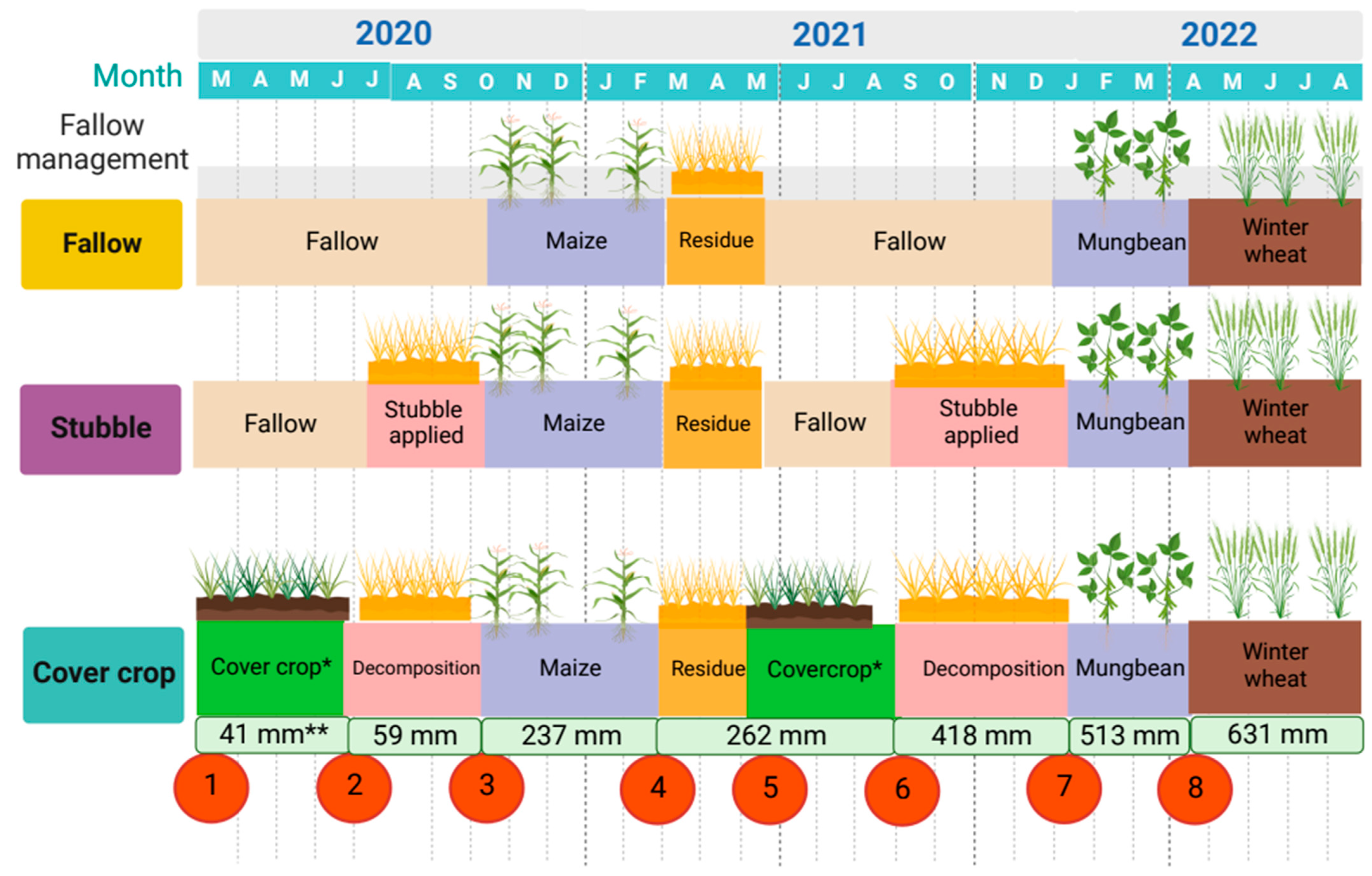
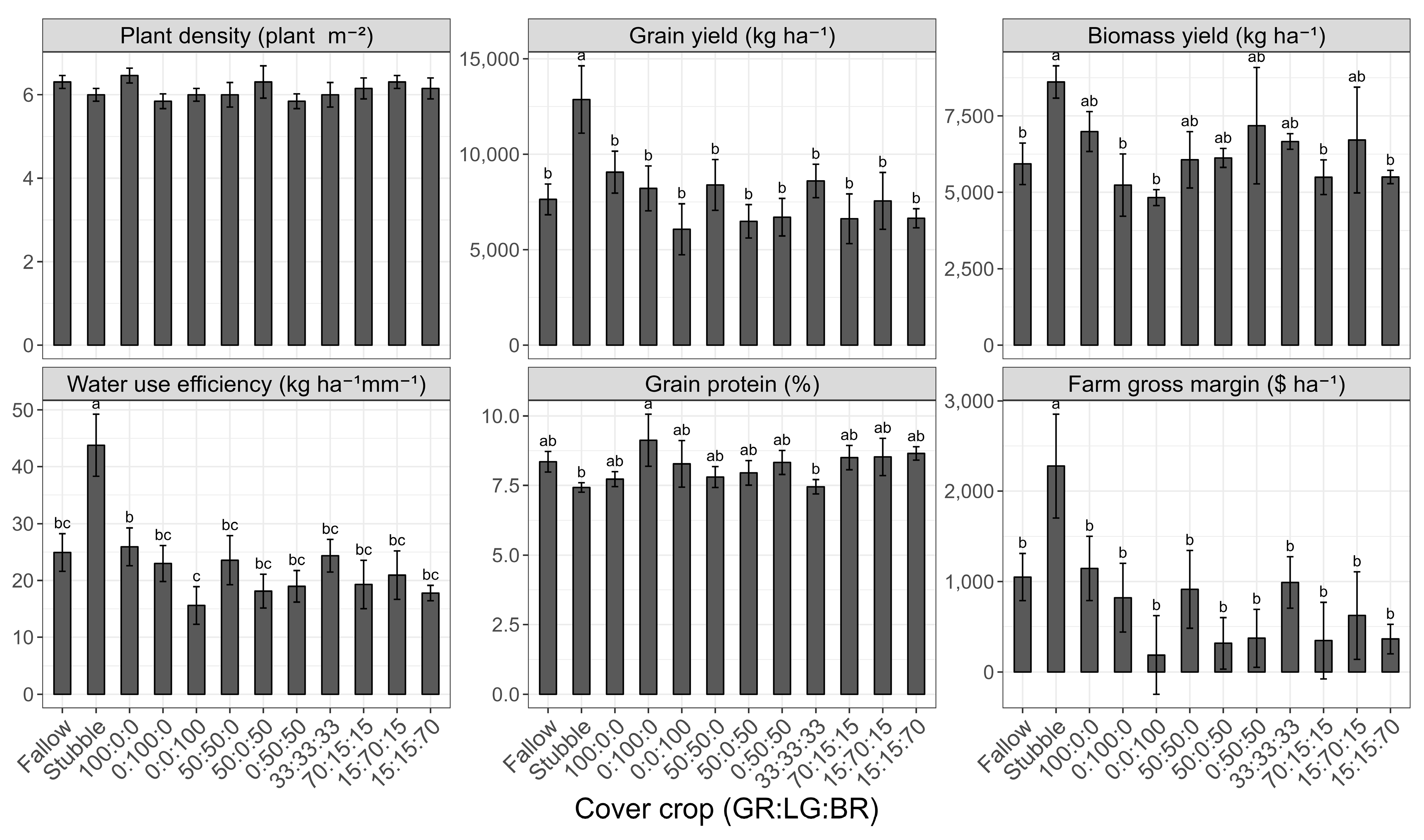
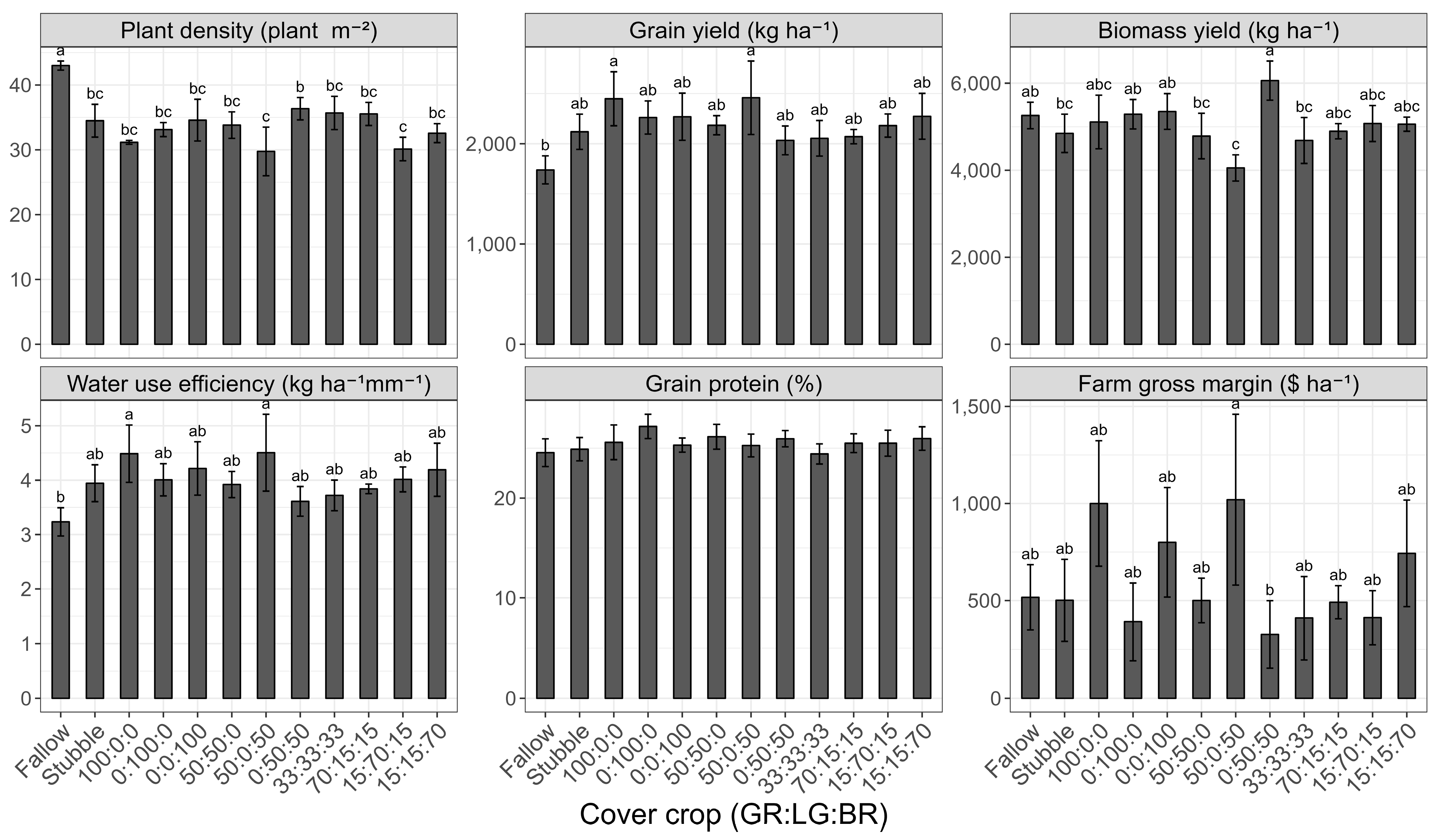

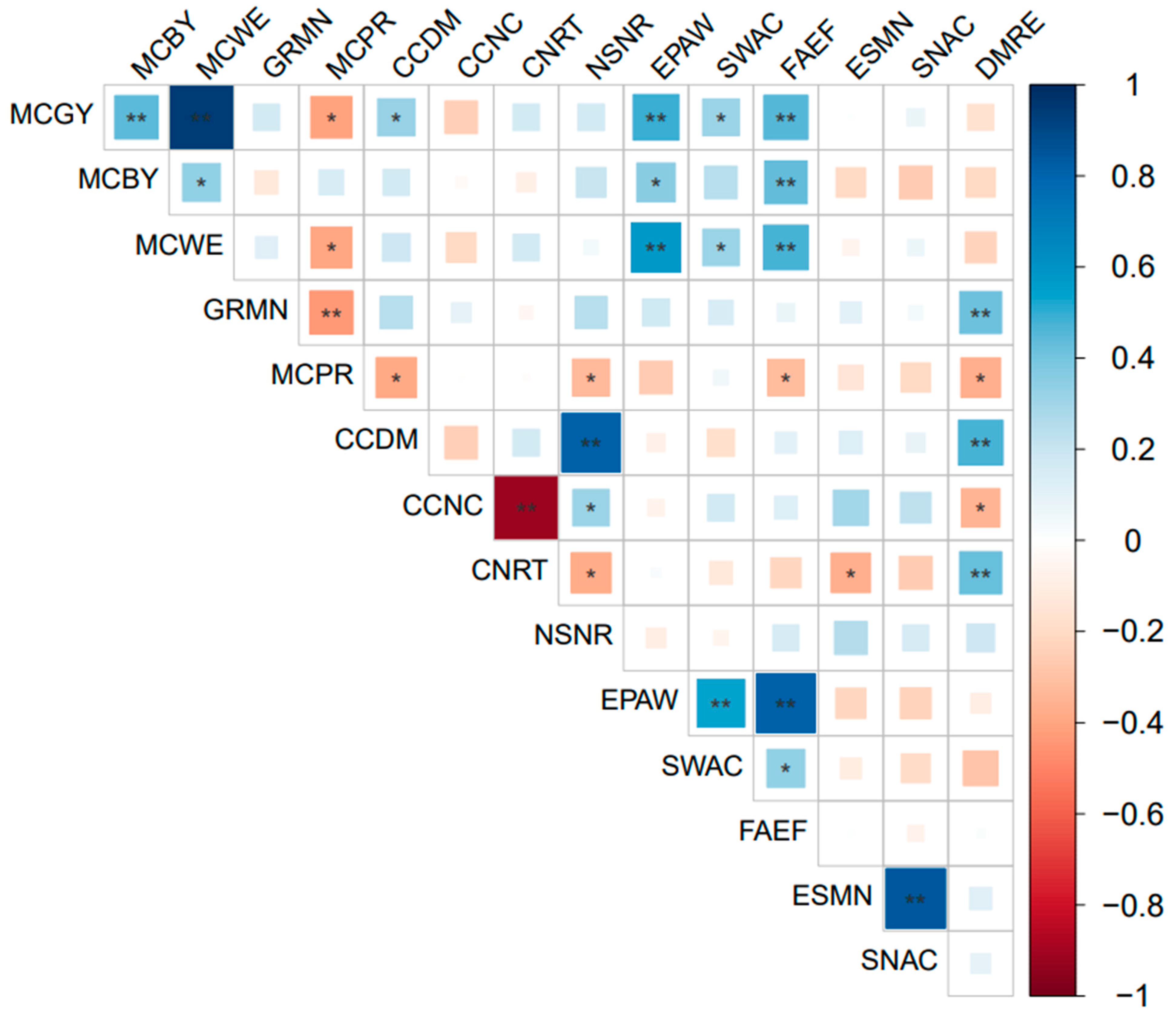
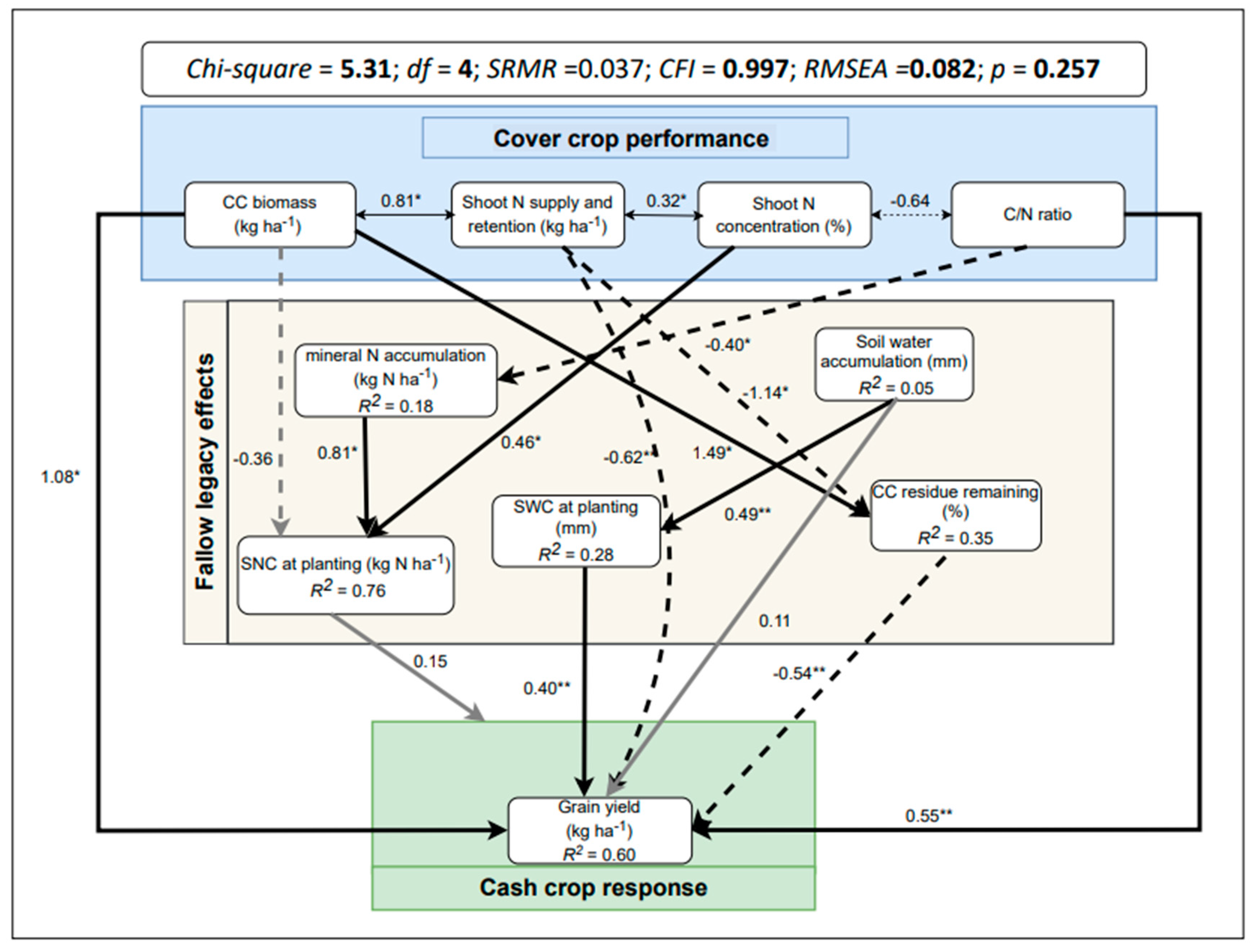
| Grass (GR) | † Legume (LG) | Brassica (BR) | ||
|---|---|---|---|---|
| Treatment (GR:LG:BR) | Forage Oat | Common Vetch | Fababean | Forage Rape |
| Conventional fallow | - | - | - | - |
| Stubble | - | - | - | - |
| Fallow | 40 | - | - | - |
| Stubble | - | 40 | 200 | - |
| 100:0:0 | - | - | - | 4 |
| 0:100:0 | 20 | 20 | 100 | - |
| 0:0:100 | 20 | - | - | 2 |
| 50:50:0 | - | 20 | 100 | 2 |
| 50:0:50 | 13.2 | 13.2 | 66 | 1.32 |
| 0:50:50 | 28 | 6 | 30 | 0.6 |
| 33:33:33 | 6 | 28 | 140 | 0.6 |
| 70:15:15 | 6 | 6 | 30 | 2.8 |
| Management | Rate (kg ha−1) | Date | Method | |
|---|---|---|---|---|
| Year 1 | ||||
| 1 | GranulockZ fertiliser | 30 | 20 March 2020 | Banded |
| 2 | Cover crop sowing | 23 March 2020 | Drill | |
| 3 | Cover crop termination | 23 June 2020 | Chemical: Glyphosate at 2.4 L ha−1 + sharpen (700 g kg−1 saflufenacil) plus 1% v/v hasten adjuvant | |
| 3 | Basal urea application | 120 | 18 October 2020 | Banded |
| 5 | Cash crop sowing | 20 October 2020 | Mechanical | |
| 6 | Top dress urea | 60 | 14 November 2020 | Banded |
| 7 | Cash crop harvest | 20 February 2021 | Drill | |
| Year 2 | ||||
| 8 | Cover crop sowing | 25 May 2021 | Drill | |
| 9 | Cover crop termination | 16 August 2021 | Chemical: Glyphosate at 2.4 L ha−1 and sharpen (700 g kg−1 saflufenacil) plus 1% v/v hasten adjuvant | |
| 10 | Basal urea application | 120 | 02 November 2021 | Banded |
| 11 | Cash crop sowing | 13 January 2022 | Drill | |
| 12 | Cash crop harvest | 12 April 2022 | Mechanical | |
| Year 3 | ||||
| Pre-sowing herbicide | 27 May 2022 | Chemical: Glyphosate at 2.4 L ha−1 and sharpen (700 g kg−1 saflufenacil) plus 1% v/v hasten adjuvant | ||
| Cash crop sowing | 02 June 2022 | Drill | ||
| Cash crop harvest | 10 November 2022 | Mechanical | ||
| Treatment (GR:LG:BR) | PAW at Cash Crop Sowing (mm) | Fallow Efficiency (%) | SMN at the Cash Crop Sowing (kg N ha−1) | Net Soil Mineral N Mineralization between Cover Crop Termination and Cash Crop Sowing (kg N ha−1) | Residue Remaining at Cash Crop Sowing (%) | |||||||||||||||
|---|---|---|---|---|---|---|---|---|---|---|---|---|---|---|---|---|---|---|---|---|
| † Min | β Max | Mean | ϕ CV | Min | Max | Mean | CV | Min | Max | Mean | CV | Min | Max | Mean | CV | Min | Max | Mean | CV | |
| Fallow | 121 | 175 | 154 | 13.3 | 32 | 46 | 40 | 12.3 | 171 | 219 | 197 | 8.8 | 36 | 64 | 47 | 20.6 | ||||
| Stubble | 129 | 198 | 159 | 13.1 | 26 | 52 | 40 | 19.2 | 152 | 299 | 202 | 23.6 | 1 | 176 | 55 | 100.7 | 18 | 64 | 40 | 50.4 |
| 100:0:0 | 73 | 174 | 130 | 29.3 | 12 | 41 | 27 | 33.8 | 121 | 222 | 161 | 20.7 | 43 | 120 | 70 | 36.1 | 10 | 50 | 24 | 57.9 |
| 0:100:0 | 87 | 152 | 120 | 22.8 | 18 | 36 | 26 | 25.6 | 148 | 233 | 178 | 18.0 | 32 | 120 | 65 | 48.0 | 1 | 25 | 16 | 50.8 |
| 0:0:100 | 60 | 174 | 111 | 44.5 | 7 | 42 | 22 | 67.3 | 117 | 211 | 153 | 22.0 | 15 | 119 | 65 | 47.6 | 4 | 33 | 13 | 77.3 |
| 50:50:0 | 88 | 174 | 126 | 25.7 | 18 | 40 | 27 | 30.3 | 110 | 218 | 162 | 22.3 | 24 | 100 | 65 | 40.5 | 10 | 29 | 21 | 38.0 |
| 50:0:50 | 50 | 172 | 122 | 36.4 | 2 | 48 | 26 | 53.6 | 135 | 215 | 183 | 13.9 | 48 | 147 | 78 | 43.9 | 4 | 26 | 13 | 56.9 |
| 0:50:50 | 73 | 150 | 114 | 29.8 | 12 | 38 | 24 | 43.5 | 94 | 276 | 167 | 38.7 | 3 | 174 | 70 | 93.8 | 9 | 36 | 16 | 58.1 |
| 33:33:33 | 68 | 162 | 120 | 31.8 | 10 | 41 | 28 | 42.7 | 117 | 184 | 157 | 16.5 | 30 | 106 | 73 | 38.2 | 5 | 40 | 21 | 71.6 |
| 70:15:15 | 64 | 178 | 123 | 31.9 | 8 | 35 | 24 | 35.5 | 125 | 236 | 185 | 20.2 | 12 | 108 | 81 | 40.8 | 7 | 27 | 17 | 39.2 |
| 15:70:15 | 89 | 168 | 127 | 21.1 | 18 | 36 | 29 | 23.7 | 119 | 187 | 148 | 13.9 | 23 | 82 | 54 | 41.6 | 9 | 26 | 18 | 33.8 |
| 15:15:70 | 61 | 173 | 114 | 38.9 | 5 | 45 | 22 | 68.1 | 83 | 270 | 165 | 33.9 | 4 | 194 | 66 | 91.0 | 7 | 36 | 17 | 57.2 |
| Treatment (GR:LG:BR) | Aboveground Biomass (kg DM ha−1) | Shoot N Concentration (%) | Biomass C/N Ratio | Biomass N Retention (kg N ha−1) | ||||||||||||
|---|---|---|---|---|---|---|---|---|---|---|---|---|---|---|---|---|
| † Min | β Max | Mean | ϕ CV | Min | Max | Mean | CV | Min | Max | Mean | CV | Min | Max | Mean | CV | |
| Fallow | 1456 | 1816 | 1635 | 8.5 | ||||||||||||
| Stubble | 9241 | 9281 | 9266 | 0.2 | 0.6 | 2.4 | 1.5 | 59.1 | 17.2 | 69.1 | 41.5 | 60.5 | 57.8 | 222.7 | 137.9 | 59.1 |
| 100:0:0 | 3689 | 5279 | 4532 | 13.4 | 3 | 4.1 | 3.4 | 11.6 | 9.6 | 13 | 11.4 | 10.5 | 112 | 201.1 | 155.1 | 18.1 |
| 0:100:0 | 1884 | 3654 | 2581 | 26.0 | 2.6 | 4.1 | 3.1 | 15.3 | 9.1 | 15.3 | 12.1 | 19.4 | 53.8 | 197.1 | 125.3 | 38.5 |
| 0:0:100 | 4327 | 8014 | 5755 | 20.7 | 3.5 | 4.2 | 4.0 | 6.5 | 8.2 | 10.2 | 9.1 | 6.7 | 180.4 | 297.1 | 225.9 | 17.0 |
| 50:50:0 | 3571 | 5926 | 4704 | 15.2 | 2.7 | 3.8 | 3.3 | 11.7 | 10.5 | 14.8 | 11.9 | 11.2 | 152.6 | 216.5 | 174.8 | 13.1 |
| 50:0:50 | 4003 | 7321 | 5522 | 19.9 | 3.4 | 4.5 | 3.9 | 10.0 | 8.6 | 10.5 | 9.6 | 7.9 | 148.8 | 278.2 | 212.8 | 22.1 |
| 0:50:50 | 2531 | 7474 | 4422 | 40.8 | 2.7 | 3.9 | 3.5 | 13.4 | 9.5 | 13.9 | 10.6 | 14.2 | 94.8 | 285.6 | 176.7 | 40.8 |
| 33:33:33 | 3808 | 6913 | 5509 | 19.4 | 3.2 | 4.0 | 3.6 | 7.7 | 9.3 | 11.6 | 10.3 | 7.6 | 143.4 | 253.1 | 211.1 | 19.1 |
| 70:15:15 | 3878 | 9123 | 5460 | 33.7 | 3.4 | 4.1 | 3.6 | 6.7 | 9.6 | 11.1 | 10.7 | 5.5 | 153.5 | 312.6 | 204.3 | 28.1 |
| 15:70:15 | 3227 | 5965 | 4594 | 20.6 | 2.6 | 4.0 | 3.5 | 13.8 | 9.8 | 12.6 | 10.8 | 8.3 | 140.1 | 227.4 | 171.9 | 16.2 |
| 15:15:70 | 2454 | 6705 | 4885 | 29.3 | 3.3 | 4.2 | 3.8 | 9.0 | 8.8 | 12.5 | 10 | 11.3 | 90.4 | 249.1 | 191.9 | 25 |
Disclaimer/Publisher’s Note: The statements, opinions and data contained in all publications are solely those of the individual author(s) and contributor(s) and not of MDPI and/or the editor(s). MDPI and/or the editor(s) disclaim responsibility for any injury to people or property resulting from any ideas, methods, instructions or products referred to in the content. |
© 2023 by the authors. Licensee MDPI, Basel, Switzerland. This article is an open access article distributed under the terms and conditions of the Creative Commons Attribution (CC BY) license (https://creativecommons.org/licenses/by/4.0/).
Share and Cite
Garba, I.I.; Williams, A. Integrating Diverse Cover Crops for Fallow Replacement in a Subtropical Dryland: Implications on Subsequent Cash Crop Yield, Grain Quality, and Gross Margins. Agronomy 2023, 13, 271. https://doi.org/10.3390/agronomy13010271
Garba II, Williams A. Integrating Diverse Cover Crops for Fallow Replacement in a Subtropical Dryland: Implications on Subsequent Cash Crop Yield, Grain Quality, and Gross Margins. Agronomy. 2023; 13(1):271. https://doi.org/10.3390/agronomy13010271
Chicago/Turabian StyleGarba, Ismail Ibrahim, and Alwyn Williams. 2023. "Integrating Diverse Cover Crops for Fallow Replacement in a Subtropical Dryland: Implications on Subsequent Cash Crop Yield, Grain Quality, and Gross Margins" Agronomy 13, no. 1: 271. https://doi.org/10.3390/agronomy13010271
APA StyleGarba, I. I., & Williams, A. (2023). Integrating Diverse Cover Crops for Fallow Replacement in a Subtropical Dryland: Implications on Subsequent Cash Crop Yield, Grain Quality, and Gross Margins. Agronomy, 13(1), 271. https://doi.org/10.3390/agronomy13010271







